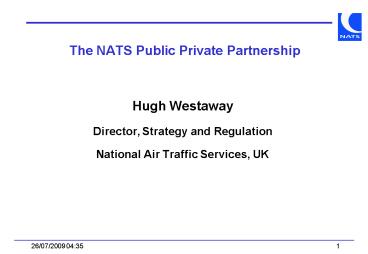The NATS Public Private Partnership - PowerPoint PPT Presentation
1 / 15
Title:
The NATS Public Private Partnership
Description:
The path to the Public Private Partnership ... Domestic en route air traffic control ( 720 million) ... easyJet. Monarch Airlines. Virgin Atlantic Airways ... – PowerPoint PPT presentation
Number of Views:115
Avg rating:3.0/5.0
Title: The NATS Public Private Partnership
1
The NATS Public Private Partnership
- Hugh Westaway
- Director, Strategy and Regulation
- National Air Traffic Services, UK
2
Introduction
Introduction
- Scope of NATS activities
- The path to the Public Private Partnership (PPP)
- The NATS PPP structure
- The advantages and challenges of the PPP
- Conclusions
3
Scope of NATS Activities
Scope of NATS Activities
- Monopoly provision of
- Domestic en route air traffic control ( 720
million) - En route control of Eastern Atlantic Ocean ( 30
million) - Competitive provision of ATS at UK Airports -
currently 14 airports, including 9 of the 10
largest ( 130 million) - Provision of infrastructure to Ministry of
Defence air traffic control on a contractual
basis ( 70 million) - 5,500 staff
- 2 million air traffic movements
4
The Path to The PPP
The Path to The PPP
- 1960s
Competitive provision of ATC at airports
- 1972
Creation of the UK Civil Aviation Authority (CAA)
as a statutory body
- 1988
Safety regulation of ATC taken out of NATS
- 1990s
NATS was twice a candidate for privatisation
- 1996
NATS formed as a corporation - a subsidiary of CAA
- 1998
Labour Government adopted concept of Public
Private Partnership for NATS
5
The Path to The PPP
The Pressures for Change
Treasury Rules
Wider Government Policy
Performance Problems
NATS
Ineffective Industry Structures
Separation from Safety Regulation
6
The Path to The PPP
Why a Public Private Partnership for NATS?
- Private Finance Initiative tried and failed for
New Scottish Centre - Full privatisation not acceptable to Labour
Government - Trust considered, but dismissed
- Public Private Partnership - key Labour policy
- No single meaning to the term Public Private
Partnership - Sometime means public purchase, private
provision - Alternatively, an arrangement in which both the
public and private sectors are involved! - For NATS PPP - a partial trade-sale
7
The Path to The PPP
PPP Timetable and Process
June 1998 PPP initially proposed July
1999 Confirmation of PPP, after public
consultation May 2000 Expressions of interest
invited Nov 2000 Short list of 3 bidders -
Airline Group consortium - Lockheed Martin led
consortium - Serco led consortium Nov
2000 Passing of Transport Act Nov 00 to Feb
01 Due diligence (eg site visits, data
room) March 2001 Government selection of Airline
Group July 2001 Completion of deal
8
The NATS PPP Structure
The Airline Group
- 7 UK based airlines with equal equity stakes
- British Airways
- Airtours International Airways
- Britannia Airways
- bmi British Midland
- easyJet
- Monarch Airlines
- Virgin Atlantic Airways
- Technical assistance from British Telecom and
several European air traffic service providers - Backed by the Single Sky Group
- Supported by the International Air Transport
Association (IATA)
9
The NATS PPP Structure
Resulting PPP Arrangements
Airline Group (46)
Government (49)
Employee Trust (5)
Stakeholder Council
CAA Safety regulation, Economic
regulation, Airspace policy
NATS Holding
NATS
En route subsidiary (monopoly business)
Airport ATC subsidiary (competitive business)
10
The Advantages and Challenges of The PPP
Advantages of The PPP
- Government, customers and NATS management share
objectives - Gives customers a real influence on NATS
performance - Introduces incentives for operating cost
efficiency - Involves customers in capital expenditure choices
- Strengthens independent safety regulation
- Encourages collaboration across the industry
(airports, airlines, other ATSPs) - Introduces some new management
- Advances Single European Sky ...
11
The Advantages and Challenges of The PPP
NATS PPP and the Single European Sky
- The PPP advances the Single European Sky by
delivering - Separation of service provision and regulation
- Transparent accounting
- Emphasis on efficiency incentives in charge
setting - Airline Group promotion of alliances and eventual
mergers - May stimulate consideration of alternative
structures for ATC in Europe
12
The Advantages and Challenges of The PPP
Challenges
- Financial constraints
- New economic regulatory regime
- Conflict of interest
- Relationship with Ministry of Defence
- Stakeholder management
- Managing the changes
13
Conclusions
Conclusions
- The NATS PPP has been a long time in the making
- It is a very specific product of the UK political
scene - It imposes major new challenges on management,
but they appear manageable - Although it is too early to judge its success in
the UK, it appears to offer some real advantages - When adapted to suit national circumstances, the
general direction of NATS PPP might provide a
useful precedent for other European countries
14
Back-up Slides
Government Bid Evaluation Criteria
- Safety management strategy
- Certainty, clarity and unconditionality
- Management capability and commitment
- Financial credibility and capacity
- Quality of strategic planning
- Net sales proceeds
- Satisfactory solutions to conflicts of interest
15
Back-up Slides
Extent of Culture Change
- Airline Group brings new shareholder expectations
- New Statutory and Regulatory environment, with
RPI-X control/ incentives - New Consultation processes, including Stakeholder
Council - New environment in Europe, probably including
competition for ATC services - New Business Strategy, competing globally as well
as strengthening UK operations - Higher Political Profile, as a flagship for PPP
and with heavy focus on safety - New opportunities from, and dependence on,
technology - New Contractual Relationships, including with
Ministry of Defence - New levels and forms of Co-operation externally
and internally































